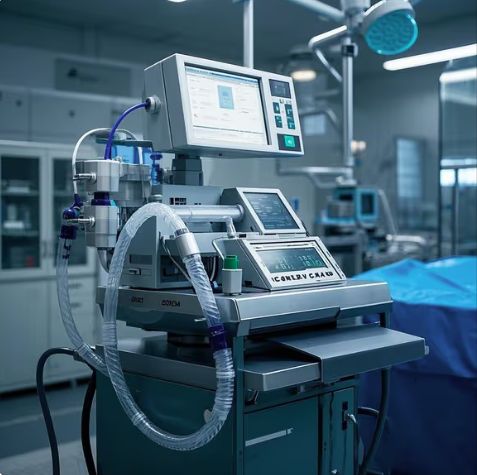The importance of medical equipment in modern healthcare systems is self-evident. From common thermometers and blood pressure monitors to high-end CT scanners and magnetic resonance imaging (MRI) equipment, they are the "trusted assistants" of doctors, providing critical support for the diagnosis, treatment, and monitoring of diseases. However, behind the effectiveness of these devices, there is an often overlooked but crucial aspect - the positioning of medical equipment. It is like a hero behind the scenes in the medical field, silently ensuring the efficient development of medical work.

Imagine having hundreds or thousands of various medical devices in a busy large hospital. From outpatient departments to inpatient departments, from operating rooms to laboratory departments, every device serves patients at different times and locations. Without precise positioning technology, medical staff may spend a lot of time searching for a certain device when they urgently need it, and may even delay the patient's treatment due to the inability to find the device. This not only reduces medical efficiency, but may also have a serious impact on the life and health of patients.
The importance of medical equipment positioning goes far beyond that. It also plays a crucial role in the management and maintenance of medical equipment. By real-time positioning of equipment, hospital management personnel can understand the usage status and location distribution of equipment at any time, arrange the allocation and use of equipment reasonably, avoid equipment idle waste, and improve equipment utilization. At the same time, for the maintenance and upkeep of equipment, positioning technology can help maintenance personnel quickly locate faulty equipment, carry out timely repairs, ensure the normal operation of equipment, and reduce medical service interruptions caused by equipment failures.
What is the positioning of medical equipment
Medical equipment positioning, in simple terms, refers to determining the specific location of medical equipment in hospitals or other medical facilities. It utilizes a series of advanced technological means to give each medical device its own "location identifier", just like installing a "locator" on the devices, so that they can be quickly and accurately found no matter where they are in the hospital.
There are various technologies for achieving medical device positioning, including Bluetooth positioning, RFID (Radio Frequency Identification) positioning, UWB (Ultra Wideband) positioning, etc. They each have unique principles and advantages.
Bluetooth positioning technology is certainly not unfamiliar to everyone. It is widely used in daily life, such as connecting Bluetooth earphones, Bluetooth speakers and other devices. In the field of medical device positioning, Bluetooth positioning is based on the RSSI (Received Signal Strength Indication) principle. Simply put, it is to estimate the distance between devices by measuring the strength of Bluetooth signals. Because the strength of Bluetooth signals decreases with distance, the distance between medical equipment and positioning base stations can be determined based on changes in signal strength. By receiving signals from multiple base stations and combining them with certain algorithms, the specific location of the device can be determined. Bluetooth positioning has low cost and relatively simple deployment, making it suitable for applications in scenarios where positioning accuracy is not particularly high, such as medical equipment positioning in ordinary wards. Like some small medical monitoring devices, medical staff can roughly understand their location in the ward through Bluetooth positioning.
RFID positioning technology uses radio frequency signals to identify and locate target objects. The RFID system mainly consists of electronic tags, readers, and antennas. Electronic tags are attached to medical equipment and store relevant information about the device. When the device enters the RF field of the reader/writer, the tag will be activated and send the stored information to the reader/writer. The reader/writer receives signals through an antenna and processes and analyzes the signals to obtain location information of the device. The advantage of RFID positioning is that it can simultaneously identify multiple tags and penetrate obstacles to a certain extent. However, its positioning accuracy is relatively limited, and it is generally suitable for roughly tracking and managing the location of equipment, such as managing the storage location of a large number of medical equipment in hospital material warehouses.
UWB positioning technology, also known as ultra wideband technology, is an emerging high-precision positioning technology. It uses nanosecond level non sinusoidal narrow pulses to transmit data, with a wide spectral range. Unlike traditional positioning technology, UWB positioning adopts broadband pulse communication technology, which has strong anti-interference ability and can achieve centimeter level positioning accuracy. The positioning principles mainly include Time Difference of Arrival (TDOA) positioning method, Time of Flight (TOF) ranging method, etc. Taking TOF as an example, the tag and each base station that needs to be located initiate ranging, and the distance between the tag and the base station is determined by measuring the flight time of the signal between the two. By combining the distance information between multiple base stations and tags, the precise location of the tag (i.e. medical equipment) is calculated using a specific algorithm. UWB has high positioning accuracy and strong real-time performance, making it very suitable for precise positioning of key medical equipment such as high-end surgical instruments in operating rooms and important life support equipment in intensive care units, ensuring that it can be quickly found and used in emergency situations.
Prev:Court personnel positioning system
Next:Unveiling the Application Scenarios of Medical Equipment Positioning
Copyrights© Shenzhen Skylab Co.,LTD All Rights Reserved.

